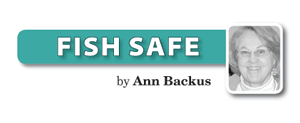Well, the holidays are upon us and for some fishermen who don’t fish in the winter, some downtime, so to speak.
Or, perhaps we should just call it a change in the work routine rather than downtime.
Are you, or someone you know planning to repaint or refinish your boat this winter?
Or perhaps you’re just taking on some overdue household chores that might involve stripping, sanding, and/or repainting.
If so, here is a story about paint strippers that is important information for your health and that of your family.
In early November, South Carolina public radio aired a story about a local mother, Cindy Wynne, who lost her 31-year-old-son in October 2017 to sudden death from exposure to a paint stripper that contained methylene chloride.
He was stripping paint in a walk-in refrigerator when he collapsed and died. The report cited that over 50 people have died from this same exposure since 1980.
Shortly after her son’s’ memorial service Mrs. Wynne learned that the Environmental Protection Agency (EPA) had abandoned a proposal to ban methylene chloride.
Having originally determined — after undertaking a risk assessment — that methylene chloride should be banned because it presents an “unreasonable risk” to human life, the EPA had subsequently dropped the idea.
According to the public radio report, Wynne and another mother whose son had also succumbed to methylene chloride, traveled to Washington, DC where they met with Scott Pruitt, then head of EPA.
Several days later, the intention to ban methylene chloride was back on.
But nothing happened.
Then the organization Safer Chemicals, Healthy Families, in collaboration with the Environmental Defense Fund (EDF), and families, mounted a campaign to get retailers to pull the products from their shelves.
Lowe’s, Home Depot, and Sherwin Williams got on board and other retailers joined in. According to the public radio report, “thousands of stores will stop selling methylene chloride by this coming January.”
Implications for the fishing industry
But wait, where does the fishing industry fit in now that it appears that the intent to ban methylene chloride is back on. The final rule is scheduled for publication later this month.
Among industrial sectors affected will be painting and wall covering contractors, flooring contractors, chemical manufacturing, aircraft manufacturing, and shipbuilding and repairing (NAICS code 336611).
Marine suppliers in this region currently sell Strypeeze which contains methylene chloride (25-30% by weight) also known as dichloromethane (DCM); and a variety of other marine paint removers that contain DCM. Other brand names available in general hardware stores include Goof-Off, Klean-Strip, and Jasco.
Use with caution
These materials are extremely hazardous. While methylene chloride is itself not flammable, in strippers it is combined with highly flammable compounds such as toluene, acetone, xylene, and methanol.
Starting with flammability, users must remove sparks and sources of ignition such as pilot lights, fans, heaters, and other small appliances. Some safety data sheets even recommend turning off the electricity to electrical outlets.
With respect to toxicity: strippers with DCM are harmful if swallowed, dangerous to skin and eyes, and potentially fatal if inhaled. Appropriate personal protective equipment (respirator) is suggested, outdoor use preferred, and if using indoors – ventilate, ventilate, ventilate.
The various agencies that classify materials for ability to cause cancer use phrases such as “possible carcinogen” and “suspected carcinogen.”
Personal protection includes googles with side piece; gloves — preferably laminate film gloves not neoprene, nitrile, or general household gloves as they will disintegrate quite soon — long sleeves; and well-protected skin.
Neither food nor drink should be in the area; hands should be washed after application and before eating; and clothes washed promptly.
The Safety Data Sheets I could download insisted that users obtain the special instructions for use and fully read and understand them before beginning any project.
The strippers must be stored tightly closed in a locked cabinet.
For disposal, strippers should be mixed into a non-flammable/fire retardant absorbent material and disposed of as a hazardous material according to local regulations. These materials should never be disposed of in the sewer, where they can reach groundwater, or with household trash.
For methylene chloride, the CAS number is 75-09-2. CAS stands for the Chemical Abstracts Service, a database of chemicals developed by the American Chemical Society.
If this CAS number or the chemical name methylene chloride appears on the stripper container you are thinking about purchasing, put it back on the shelf and suggest to the manager that the strippers be removed from the shelves.
If you do end up purchasing one of these products, take the Safety Data Sheet (SDS) home with you and obtain the special instructions suggested on the label or the SDS.
The good news is researchers at the Toxic Use Reduction Institute at UMASS Lowell are close to releasing a safer stripper.
Discussion and a video about this product is available at <https://www.turi.org/Our_Work/Research/Paint_and_Coating_Removal>.
Ann Backus, MS, is the director of outreach for the Harvard School of Public Health’s Department of Environmental Health in Boston, MA. She may be reached by phone at (617) 432-3327 or by e-mail at <abackus@hsph.harvard.edu>.
FISH SAFE
• Avoid the use of paint strippers that contain methylene chloride (DCM).
• Read container labels and Safety Data Sheets before purchasing paint and paint remover products.
• Follow instructions for use exactly to avoid explosion and exposure.
• Have a safe holiday and winter season.






